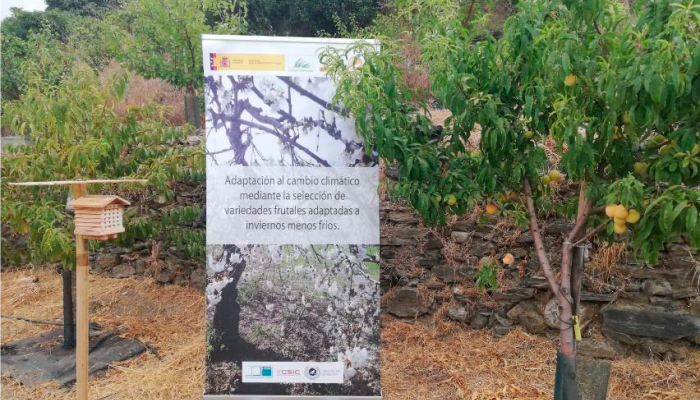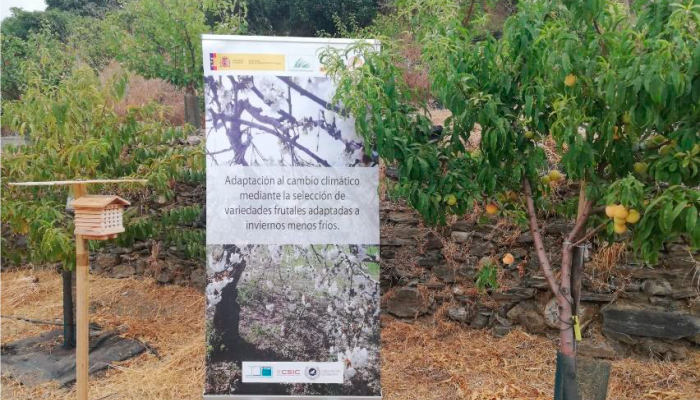
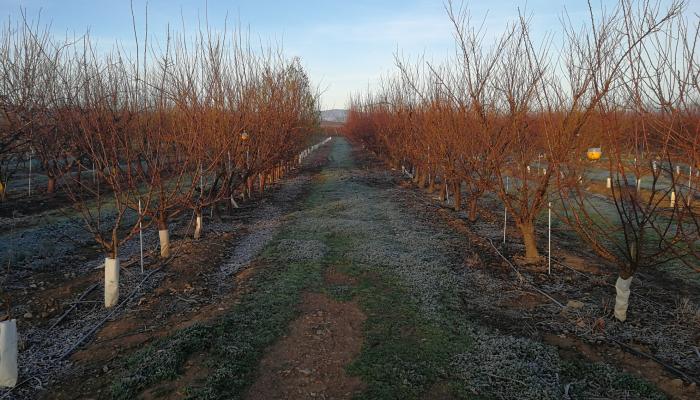
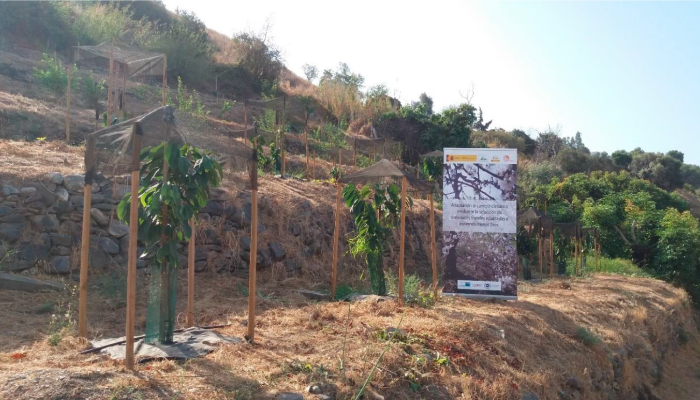
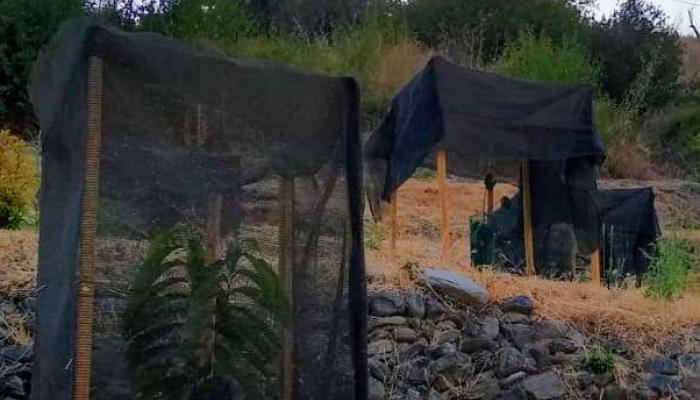
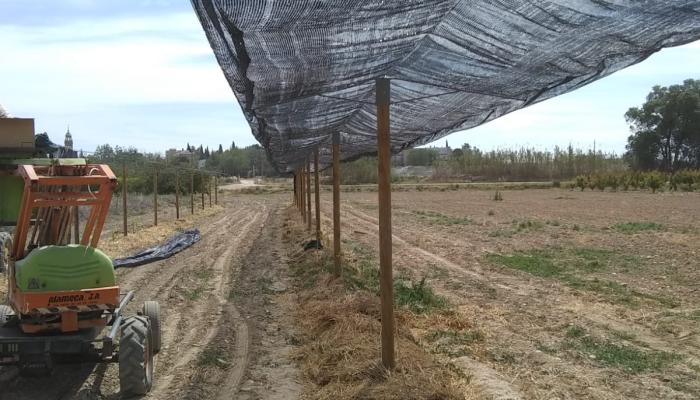
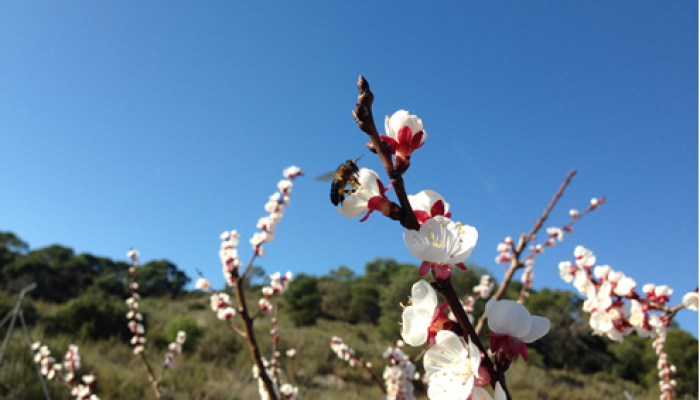
riesgo de daño por heladas tardías.
The winter months. In the case of temperate-zone fruit trees, these phenological changes are often associated with flowering problems in some areas due to insufficient winter chill.
Phenological studies have been conducted on different species of temperate fruit trees in two geographic areas with contrasting climates: the coast of Málaga, which is frost-free and has few winter chill hours, and the Ebro Valley in Zaragoza, which has many chill hours—though decreasing—and a high risk of frost.
All species flower in the Ebro Valley, but some that require more winter chill do not flower in Málaga. However, certain low-chill varieties can flower and produce under such conditions, making their selection possible and allowing varietal renewal in areas where a lack of winter chill threatens the profitability of current fruit crops.
Climate change models forecast a rise in average temperatures during the winter months. These forecasts are being confirmed by recent observations of phenological changes in various plant species, both cultivated and wild, showing a trend toward an earlier onset of developmental processes.
In the case of temperate-zone fruit trees, these phenological changes are often linked to flowering problems in certain areas due to insufficient winter chill.
Over the past centuries, farmers have conducted an empirical selection of fruit crop varieties adapted to different geographic regions based on their winter chill requirements to exit dormancy efficiently.
This rapid decline in winter chill hours may result in some cultivated fruit tree varieties failing to produce regular harvests. Therefore, it would be advisable to adapt to these new conditions through varietal renewal. However, an immediate renewal could lead to low-chill varieties flowering too early in colder regions, making them vulnerable to frost damage.
The fundamental objective of this project is to analyse and compare the cultivation and harvest potential of selected fruit tree varieties in different geographic areas subject to varying winter chill conditions. Particular attention is given to the absence of frosts that can burn buds and shoots, preventing or delaying flowering.
The goal is to support the renewal of specific varieties that are better adapted to milder winter conditions, as a response to projected temperature increases due to climate change—particularly significant in some regions.
These phenological studies involving different species and varieties of fruit trees were conducted in two geographic zones with very distinct climates:
- The coast of Málaga is a frost-free area with very few winter chill hours (subtropical peninsular climate).
- The Ebro Valley in Zaragoza, with a high number of chill hours, though decreasing, and a high risk of frost (continental peninsular climate).
In line with this, the project pursued three secondary development objectives:
- The planting of two collections of the same varieties from different species—peach trees (Prunus persica L.), apricot trees (Prunus armeniaca L.), Japanese plum trees (Prunus salicina Lindl), and cherry trees (Prunus avium L.)—in both climate scenarios. Various varieties of pawpaw (Asimina triloba L.), an exotic temperate-zone fruit tree, were also studied, although they have not yet produced fruit.
- The evaluation of flowering phenology for these fruit trees in both locations, with the first fruits already harvested.
- The dissemination of the activities carried out and raising awareness about climate change's impact on fruit trees' reproductive biology.
The project was carried out on three plots: one located on the grounds of the Instituto de Hortofruticultura Subtropical y Mediterránea (IHSM) "La Mayora", part of the Spanish National Research Council (CSIC), on the coast of Algarrobo in Málaga; and two others located in the Ebro Valley near Zaragoza—one to the south of La Almunia de Doña Godina, and the other to the north of the city, on the grounds of the Agri-Food Research and Technology Centre of Aragón (CITA).
The first site, on the Málaga coast, lies at an average altitude of 34 m a.s.l. and has a subtropical peninsular climate. The other two locations lie at approximately 403 and 218 m a.s.l., respectively, and are representative of a typical continental peninsular climate. The activities carried out included:
- land preparation
- planting, fertilisation, irrigation, and phytosanitary treatments
- installation of posts and shading nets
- management of pollinating insects
Two trees of each selected genotype were planted, taking advantage of one of the fruit trees' benefits for such studies: grafting ease, which allows the same genotype to be studied under different environmental conditions.
The planting took place in March 2017, with the first flowering and first harvest of surviving trees occurring in spring and summer 2019, respectively. In Málaga, a total of 32 trees were planted (Asimina, apricot, Japanese plum, peach, and cherry trees), with 30 surviving specimens by summer 2019. In La Almunia, 8 trees were planted (apricot, Japanese plum, peach, and cherry), with all specimens surviving.
At the CITA plot, two identical plantings of Asimina were carried out—one in February 2017 and another in the same period in 2019. On both occasions, 28 Asimina trees were planted. The second planting was done due to the loss of the 2017 specimens. The survival rate of the second planting was 100% in summer 2019, although they have not yet entered production..
Winter chill was accumulated earlier and in greater quantity in La Almunia and CITA (Zaragoza) than in IHSM La Mayora (Málaga), showing significant differences.
Conversely, in Málaga, heat units accumulated earlier and in greater quantity than in the two Zaragoza locations. However, it is estimated that post-dormancy heat accumulation is not limiting in any of the study plots, as all three locations accumulated sufficient GDH (Growing Degree Hours).
Málaga data indicate that the minimum winter chill accumulation required for several genotypes was not met for adequate flowering.
Flowering
In all species, flowering occurred earlier in the Zaragoza locations than at IHSM La Mayora (Málaga), with differences ranging from 9 to 35 days. These variations are likely due to faster and more substantial winter chill accumulation in the Ebro Valley sites. In La Mayora, some varieties took longer to meet their chill requirements, resulting in delayed flowering. One cherry variety that did not flower in Málaga may have had chill requirements that were too high to be fulfilled.
Fruit Ripening
Ripening did not follow a consistent pattern and varied across species and locations. More varieties ripened earlier in Málaga, although some also ripened earlier in Zaragoza. For instance, some peach trees in Zaragoza ripened two weeks earlier. Varieties with low chill requirements, such as certain apricot and plum varieties, though they may flower later in warmer zones, can ripen earlier due to faster post-dormancy heat accumulation.
However, ripening of some apricot varieties occurred simultaneously in both sites, while others ripened earlier in La Mayora. Plum trees ripened much earlier in La Mayora, while no cherry data were available due to a lack of harvest or for some peach varieties damaged by spring frost in La Almunia.
Asimina
In Zaragoza, the Asimina trees grew poorly and died during the first year, so there are no flowering or ripening data. Their lack of adaptation was attributed to the intense solar radiation on the hottest days. To address this, the second planting in 2019 included shading structures to prevent root overheating. The tree rows were also mulched with straw, avoiding the use of herbicides, another potential cause of tree mortality.
In La Mayora (Málaga), there was no flowering of Asimina during spring 2019, but flowering is expected in 2020, as the trees are showing healthy vegetative growth.
The phenological changes that occur in trees due to insufficient winter chill are often associated in some areas with flowering problems, including weak and irregular bud break, which usually happens late, with scarce flowering and poor fruit set.
Deciduous fruit trees, like those studied in this project, have a dormancy period between vegetative cycles. To exit winter dormancy, buds (both floral and vegetative) must first be exposed to low temperatures during the chill accumulation period (endodormancy), followed by moderate temperatures during the heat accumulation period (ecodormancy).
During endodormancy, there is a visible temporary suspension of the growth of any plant structure containing a meristem. This is part of the annual cycle of deciduous fruit trees and is induced by low autumn temperatures along with shorter day length.
The duration of dormancy depends, among other factors, on the species and variety. Within each plant, it varies according to the type of bud, its location on the plant, and its age.
Cold accumulation restores the capacity to grow but does not trigger growth. Subsequently, once buds have accumulated the crop-specific amount of heat, the flowering or vegetative bud break processes are triggered. The availability of water and nutrients also regulates the exit from ecodormancy.
To flower, buds must fulfil the specific quantitative requirements for each species and variety during both stages.
Thus, in geographical areas with mild winters, some species may not meet their chill requirements, although the heat requirement is generally satisfied, and the flowering date will vary depending on the rate of heat accumulation.
In this sense, the most versatile fruit tree varieties for achieving acceptable harvests in diverse geographic zones are those with low chill and high heat requirements. The low chill requirement allows them to succeed even in areas with mild winters, while the high heat requirement leads to late flowering, helping them avoid potential late frosts.
It is therefore particularly important to select varieties that are adapted and adaptable to environmental conditions expected in the coming years, marked by rising temperatures due to climate change, with milder winters and harsher summers.
Varieties with low chill and high heat requirements will be able to thrive and produce in regions with mild winters, potentially delaying or shifting their flowering and fruit ripening dates.
The project was developed on the initiative of the Instituto de Hortofruticultura Subtropical y Mediterránea "La Mayora" – CSIC – UMA in Málaga, with the collaboration of the Centro de Investigación y Tecnología Agroalimentaria de Aragón (CITA) in Zaragoza.
In addition, it received support and participation from various entities:
Viveros Mariano Soria, supplier of Prunus sp. plant material
Viveros Lurberry, also a supplier of Asimina sp. plant material
Agrigan SA., as the company responsible for installing stakes and shading nets
Asociación de Fruticultores de la Comarca de Caspe (Afruccas)
- Agroseguro: Agricultural Insurance Entity
The agricultural sector in Spain is strategic due to its economic, environmental, social, and territorial relevance, but it may suffer significant impacts as a result of climate change because of its high exposure and vulnerability. A better understanding of crops and their relationship with the climate—both current and projected—can support the sector's adaptation by enabling the selection of better-adapted and more resilient varieties.
Accurate information on the thermal requirements of certain fruit tree varieties is essential to select the most suitable varieties and to carry out a zoning process that rationalizes their cultivation and maximizes their use in agroclimatically suitable areas.
Likewise, precise information on the behaviour of these fruit tree varieties in relation to two distinct climatic areas—such as the Ebro Valley and the subtropical coast of Málaga—will help determine the interannual variation in their chill and heat requirements and their relationship with ambient temperature conditions. This will make it possible to design management practices aimed at delaying flowering and thereby reducing the risk of damage from late frosts.
This differing behaviour could be due to the differences in chill and heat requirements among varieties, so that those with higher chill needs, such as some cherry varieties, may delay their ripening in the warmer zone, as they may take much longer—or may not even meet—their chill requirements.
On the other hand, varieties with lower chill requirements, such as some apricots or plums, while they may delay their flowering in the warmer zone, could advance their ripening due to the faster and greater heat accumulation after dormancy.
A distinctive aspect of the project was the implementation of dissemination, outreach, awareness-raising, and training activities regarding the effects of climate change on the reproductive biology of fruit trees and adaptive varietal selection and agricultural practices among farmers and stakeholders. In this regard, and among other activities, two events were held at two of the three project sites:
- La Almunia de Doña Godina (Zaragoza), providing information about the planting of Prunus varieties in the Ebro Valley.
- Costa del Algarrobo (Málaga), providing information on the planting of both Prunus and Asimina varieties.
The data collected in this project will be complemented in the coming years with the calculation of the chill requirements of each of the varieties used, which have not yet been analysed due to the young age of the trees and the insufficient number of buds for study. This will allow for a more precise understanding of how chill and heat requirements influence the behaviour of each variety in each location.
Adaptation to climate change as a goal in the genetic improvement of most of the fruit tree species studied in the project has not been considered until recently. However, it can be said that genetic improvement has been carried out indirectly to adapt their production to generally warm-temperate climates.
In this regard, the objectives set out in the project have been sufficiently met, proceeding with the planting of two collections of the same varieties from different deciduous fruit tree species typical of our latitudes and of significant economic interest (peach, apricot, Japanese plum, and cherry trees) in two contrasting climate scenarios representative of different agroclimatic areas: continental and coastal subtropical.
The possible viability of cultivating and producing various varieties of Asimina has also been studied. In its second trial under continental conditions in the Ebro Valley, the trees have vegetated but have not yet produced fruit.
In this way, flowering and fruit ripening phenology were evaluated for these fruit trees in both locations, resulting in the harvest of the first fruit.
In the case of peach, apricot, Japanese plum, and cherry trees, two varieties of each species were planted: one with low winter chill requirements and another with high winter chill requirements. All varieties flower in the Ebro Valley, but some of those that require more winter chill do not flower in Málaga.
However, some varieties with low chill requirements manage to flower and produce adequately under the conditions of the Málaga coast, opening the door to varietal selection that could enable varietal renewal in areas where the lack of winter chill threatens the profitability of temperate fruit crops.
Additionally, 14 varieties of Asimina triloba have been studied as an alternative fruit crop for production in temperate zones, probably better adapted to moderate-subtropical conditions like those of the Costa del Algarrobo.
Under the projected conditions of rising temperatures as a result of climate change, the decrease in winter chill hours may cause some currently cultivated fruit varieties to fail to produce consistent harvests. Therefore, it would be advisable to adapt to these new circumstances through varietal renewal. However, immediate renewal could lead to low-chill varieties flowering too early in cold regions, making them vulnerable to frost.
In this sense, the project estimated chill accumulation data using three methods:
- Chill Hours (CH)
- Chill Units (CU)
- Chill Portions (CP)
After comparing the three methods, the Chill Portions (CP) model was determined to be the most suitable for the study areas, since it takes into account not only winter chill temperatures but also the temperatures before and after in order to consolidate a chill unit (portion). In all locations, cold and warm temperatures alternated during the winter.
The project also indirectly studied the effect of increasingly high temperatures on heat accumulation during the vegetative period, which may, among other factors, affect production and the final quality of the fruits.
The project was developed with funding from the Fundación Biodiversidad, with a final estimated cost of €43,320.
Among the additional benefits of the project are those derived from the information and outreach activities on fruit tree varieties and agricultural techniques carried out, and their potential for cultivation optimisation. These activities aimed to raise awareness among farmers and producers about the effects of climate change on the reproductive biology of fruit trees in general, and about the possibility of selecting varieties that are better adapted or adaptable to the new environmental conditions associated with rising temperatures.
Regarding the use of phytosanitary products, the project has been carried out in accordance with the usage and authorization frameworks established by national and European legislation governing the use of such products.
At the national level, this legislation refers mainly to the following Royal Decrees:
- Royal Decree 971/2014, of November 21, which regulates the evaluation procedure for phytosanitary products
- Royal Decree 1311/2012, of September 14, which establishes the framework for achieving the sustainable use of phytosanitary products
- Royal Decree 2163/1994, of November 4, which implements the harmonised EU authorisation system for marketing and using phytosanitary products
At the European level, the references are primarily:
- Directive 2009/128/EC of the European Parliament and of the Council of October 21, 2009, establishing the framework for Community action to achieve the sustainable use of pesticides
Regulation (EC) No 1107/2009 of the European Parliament and of the Council of October 21, 2009 concerning the placing of plant protection products on the market
The project began with the first plantings in 2017 and was fully developed during the years 2018–2019.
However, due to the inherent nature of the full development of fruit trees and crops, it would be advisable to extend the project in the coming years in order to complete certain data, particularly the calculation of the chill requirements of each of the varieties used. This analysis could not be carried out so far because the trees are still young. Monitoring the behaviour of each variety at each location will be essential for this purpose.
- Espada Carbó J.L. 2010. Necesidades de frío invernal de los frutales caducifolios. Informaciones Técnicas, 224. Diputación General de Aragón, Dirección General de Desarrollo Rural (eds.). Talleres gráficos Los Sitios. 8 pp.
- García J.; Pérez O. et al. 2018. Influencia del cambio climático en la mejora genética de plantas. Sociedad Española de Ciencias Hortícolas, Sociedad Española de Genética e Instituto Murciano de Investigación y Desarrollo Agrario y Alimentario IMIDA (eds.). Compobell SL. 413 pp.
- Hormaza I. et al. 2019. Informe de proyecto.
- Melgarejo P. 1996. El frío invernal, factor limitante para el cultivo frutal.- Modelos y métodos para determinar la acumulación de frío y de calor en frutales. A.Madrid Vicente (ed.). 172 pp.
Iñaki Hormaza Urroz
Research Professor
Department of Subtropical Fruit Growing
Instituto de Hortofruticultura Subtropical y Mediterránea "La Mayora" – CSIC – UMA
Avda. Dr. Wienberg s/n
29750 Algarrobo, Málaga
Email: ihormaza@eelm.csic.es
Phone number: 952 548 990



